There are 5 major domesticated species of peppers. Among them are the superhots from C. chinense, and the fruity peppers from C. baccatum. However, none compare in popularity to Capsicum annuum.
The C. annuum species is home to some of the world’s most widely cultivated and popular chili pepper varieties. These include the bell, jalapeño, banana, cayenne, poblano, and countless others.
In this article, I’ll share an in-depth overview of Capsicum annuum, including its ancient origins, flavors, heat levels, and how to grow your own at home.
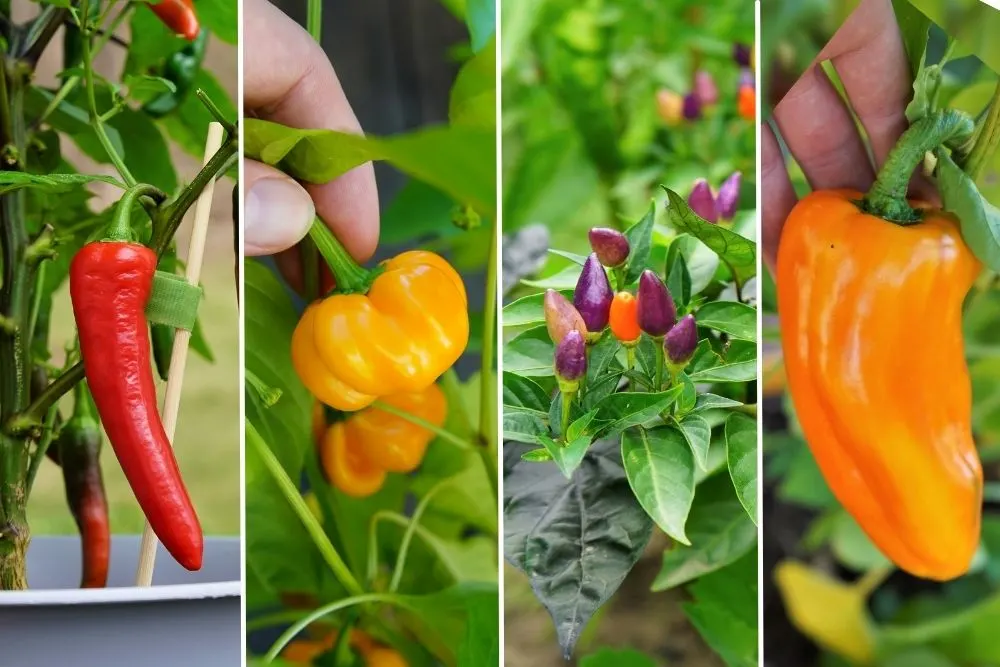
Origins
Wild chili peppers have origins in Bolivia and/or Peru. These ancient varieties have likely existed for millions of years. Most wild varieties bear small, berry-sized fruits with very little flesh.
Research indicates that C. annuum was first domesticated between 7000 and 9000 years ago in Mexico. From this point on, the plants were selectively grown to improve desired traits, such as size, heat level, disease resistance, and yield.
Fun Fact: Annuum means “annual,” but this is not an accurate description of the plants. Chili pepper plants are perennial in nature, but were cultivated as annuals in Europe, where the botanical nomenclature was created.

Christopher Columbus, responsible for mistakenly calling them “peppers,” brought chilies back to Europe where they rapidly grew in popularity around the world. He was tasked with finding black pepper (piper nigrum) on his expedition, but thought chiles were close enough…
Studies have shown that birds have a mutually beneficial relationship with chilies. Birds cannot feel the “burn” from hot peppers like humans and other mammals can. Therefore, the birds eat and spread the chile seeds far and wide.
In the millennia to follow, countless Capsicum cultivars were created around the globe, from the now omnipresent jalapeno, to the birds eye, Thai chilies, poblanos, and many others.
Capsicum Annuum Varieties
While a complete list would be impossible to complete, I’d like to share some of our favorite C. annuum varieties. They range in all aspects, including flavor, size, heat level, and color.
- Bell. No big surprise that the most popular sweet pepper variety is on the list. Huge, thick-walled pods have no heat, are sweet in flavor, and come in red, green, yellow, orange, purple, and even striped colors.
- Thai. If you have never tried a true Thai chili, then you are missing out. Perfect for adding smoky, biting heat to stir fried dishes, these peppers are special. Mix in some ginger, garlic, and a pinch of salt for a tasty hot chili paste.
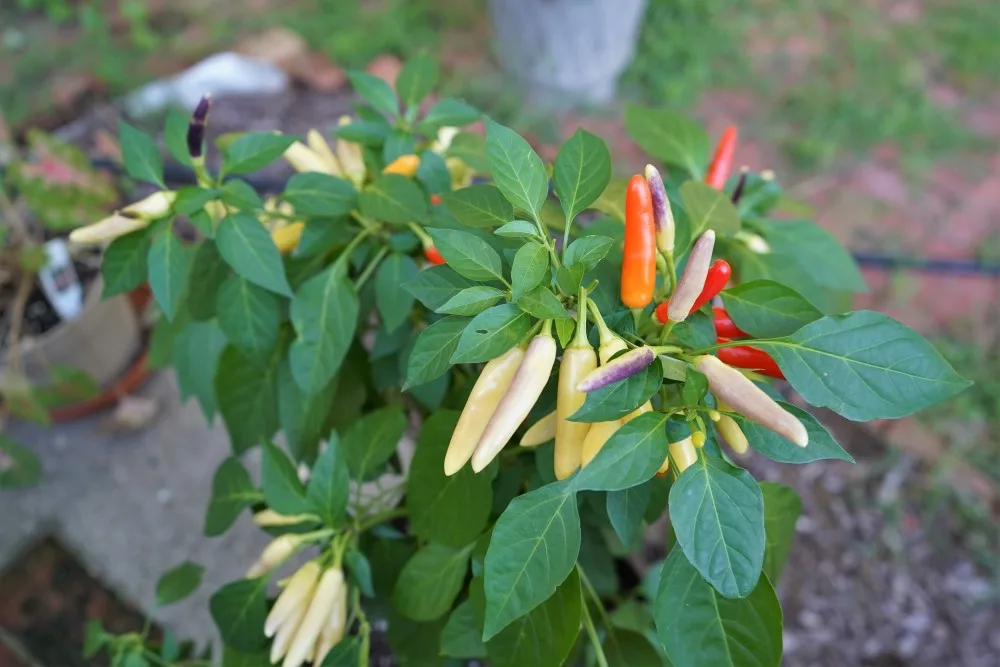
- Jalapeño. Another staple in North America. The jalapeño is a bullet-shaped pepper with medium heat (5,000-10,000 SHUs). They range in color from red to yellow and even purple. Great for spicing up chili, making spicy salsa, or stuffing with cheese for delicious jalapeño poppers.
- Cayenne. Another well-known chili, the cayenne pepper is primarily used as a powder or in hot sauce. The long fruits have the classic shape we all associate with peppers, and are very hot (~50,000 SHUs).
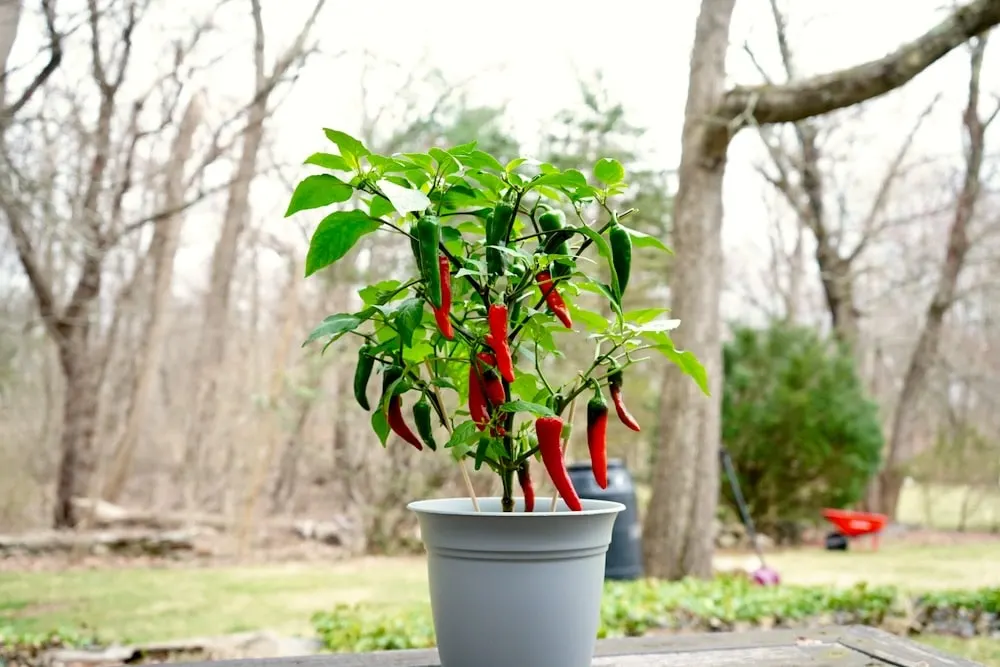
- New Mexico chiles (hatch). Many new cultivars have been developed in New Mexico at NMSU. Some are known as hatch chiles, and are typically consumed under ripe while the peppers are still green. They range from mild to spicy (500-10,000 SHUs)
- Poblano. These huge, dark green peppers have mild heat (1,000-2,000 SHUs) and have many uses. The dried form of them is known as “ancho” chile, and the fresh pods are essential in the Mexican dish of chiles rellenos. Learn how to grow poblanos here >
- Peperoncini. This is the generic Italian word for hot peppers, and there are many varieties that fall under it. Perhaps the most popular in North America are pickled green peperoncini peppers, delicious and tangy!
- Shishito. These long, crinkly peppers have thin walls, making them great as a fried appetizer. Shishito peppers have origins in Japan.
- Fish. This is one of many ornamental C. annuum varieties. The foliage has streaks and splotches of white and green, and the fruits have stripes of many colors! The fish pepper also has a special history.
- Black pearl. Another ornamental, these plants have completely dark foliage, almost black in color. The pods also ripen from black to deep red when ripe.
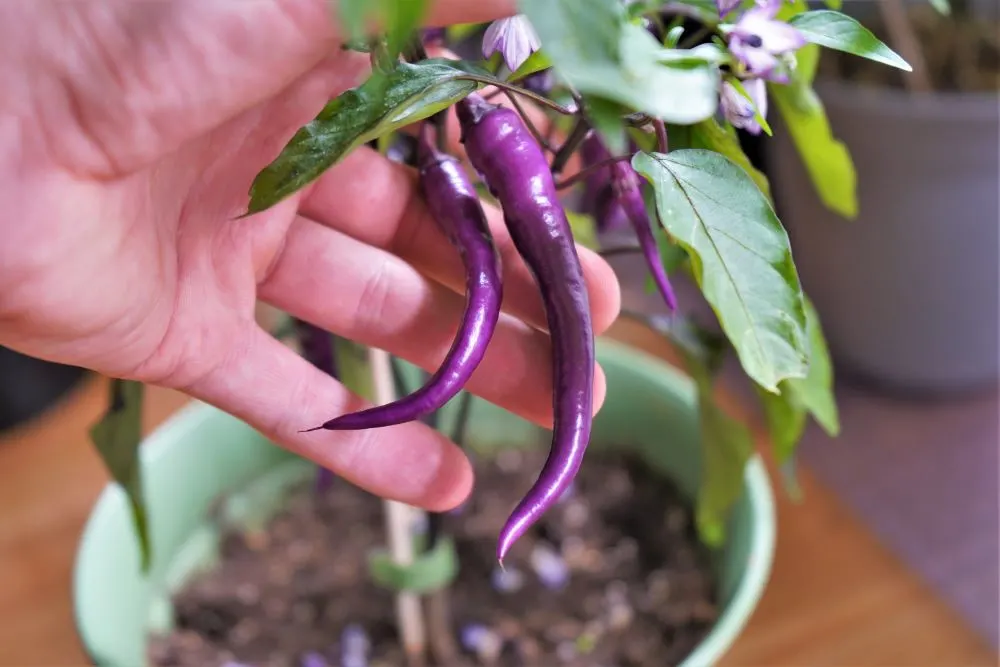
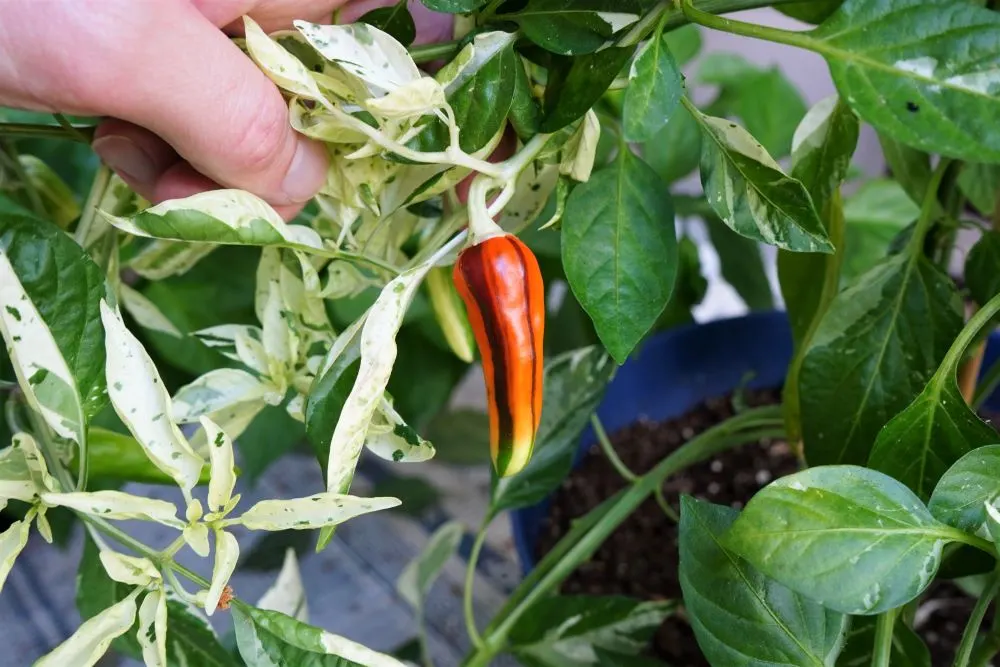
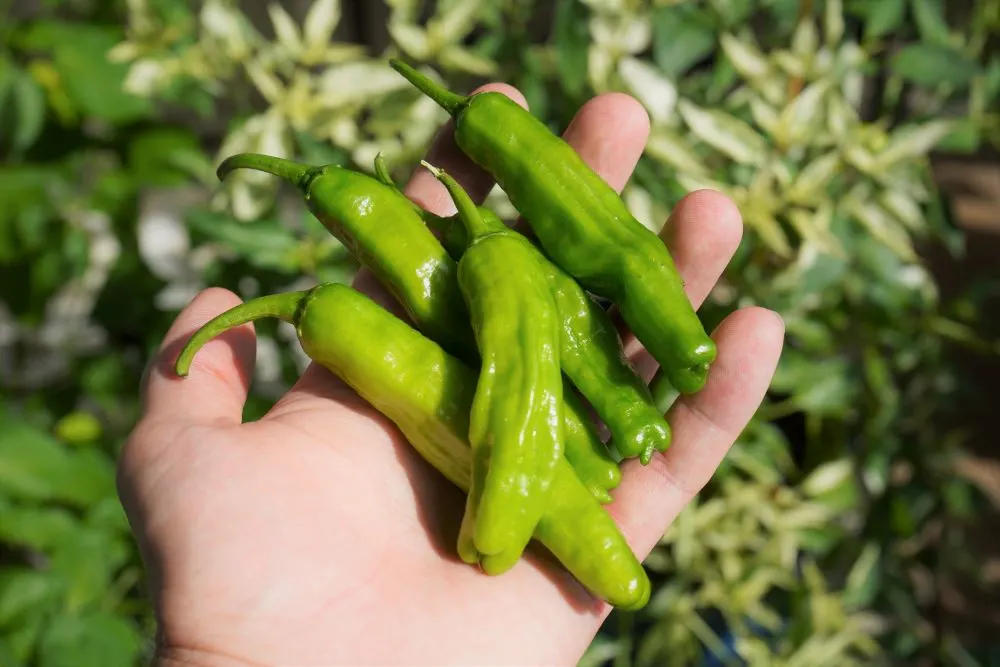
This small collection of Capsicum annuum varieties barely scratches the surface. There is incredible diversity that one can only truly discover through research and growing new types in the home garden.
Capsicum Annuum Plant Characteristics
Although Capsicum annuum is a single species, the plants within it can be wildly different in almost every way. The traits range from tall and skinny, to short and bushy, with white flowers or purple flowers, variegated foliage, and so much more.
Size
Plants are typically between 1-4 feet in height. Bell peppers have a tall and slender profile, while cayennes have a shorter and bushier shape under ideal conditions.
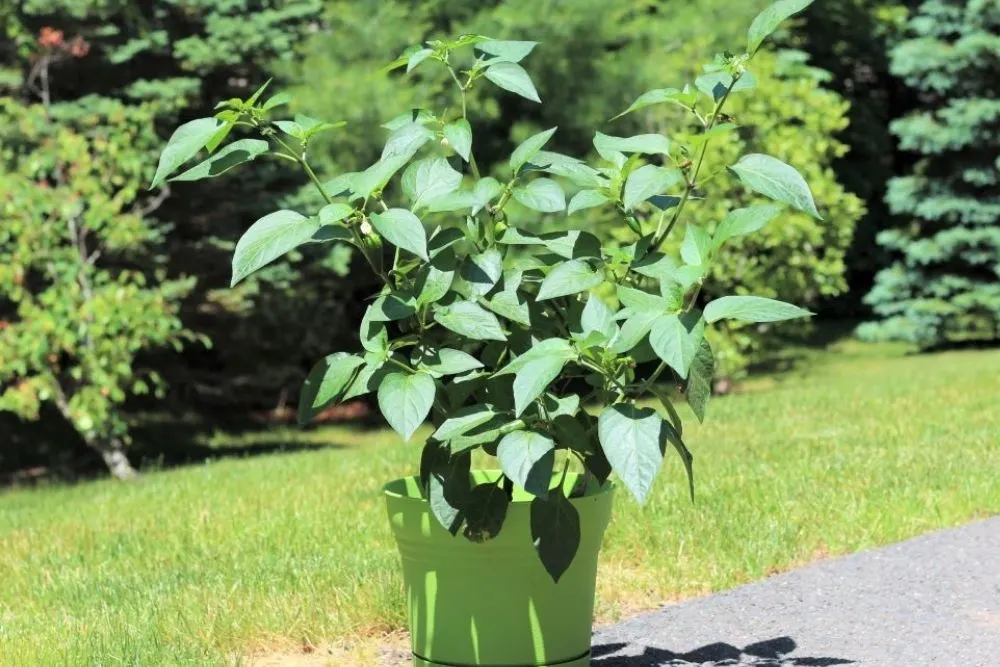
Most C. annuum varieties can benefit from staking to provide additional support. This is especially true later in the season when the fruits become heavy.
Early maturity
Many C. annuum types are prized for their early maturity. Peppers are known to take quite a while to produce when compared to other veggies. However, some jalapenos can be harvested just 60 days after transplanting.
This is one of the most important characteristics for gardeners who live in Northern climates with short growing seasons. Seeds should still be started indoors early, but no one will complain about an earlier harvest!
Flowers
The flowers on Capsicum annuum plants can be a range of colors. Most are white, however some have beautiful purple flowers.
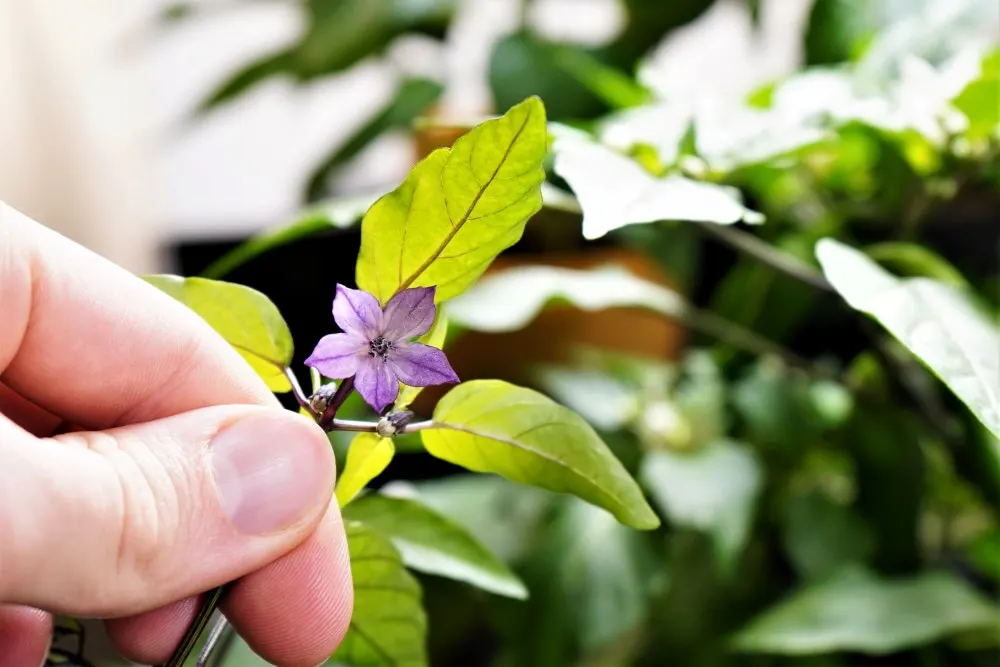
Some plants produce few flowers at each node, while others will grow several flowers in small bunches. Thai chile peppers have this trait, producing small groups of fruits at each node.
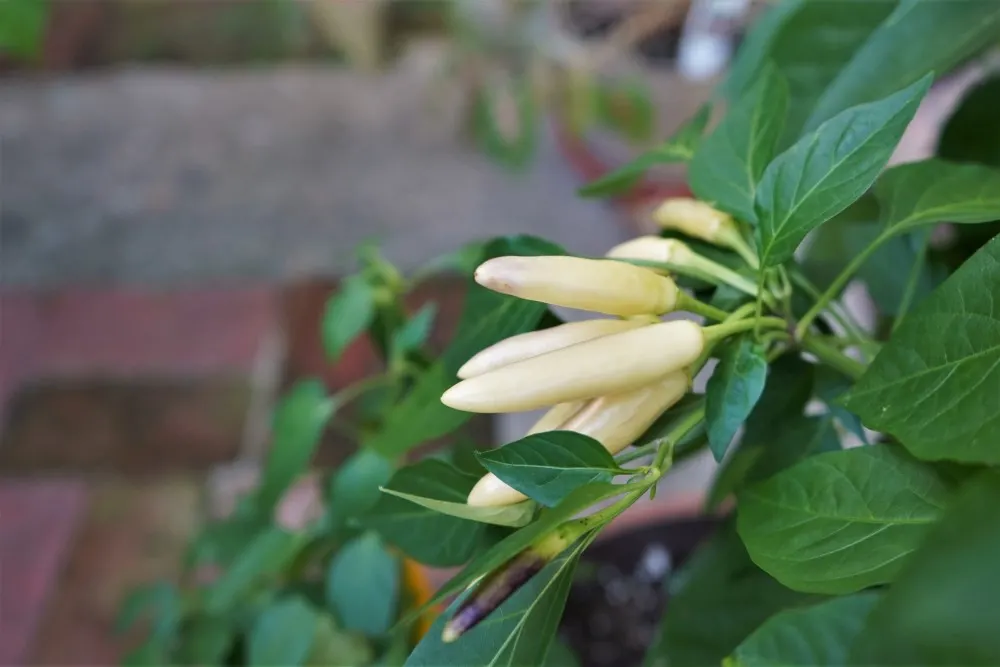
Foliage colors
Plant foliage can range in color from rich and bright green to almost black. Others will have variegated leaves, with splashes of white, purple, and green. Most common varieties are simply green, but the diversity across the species is amazing.
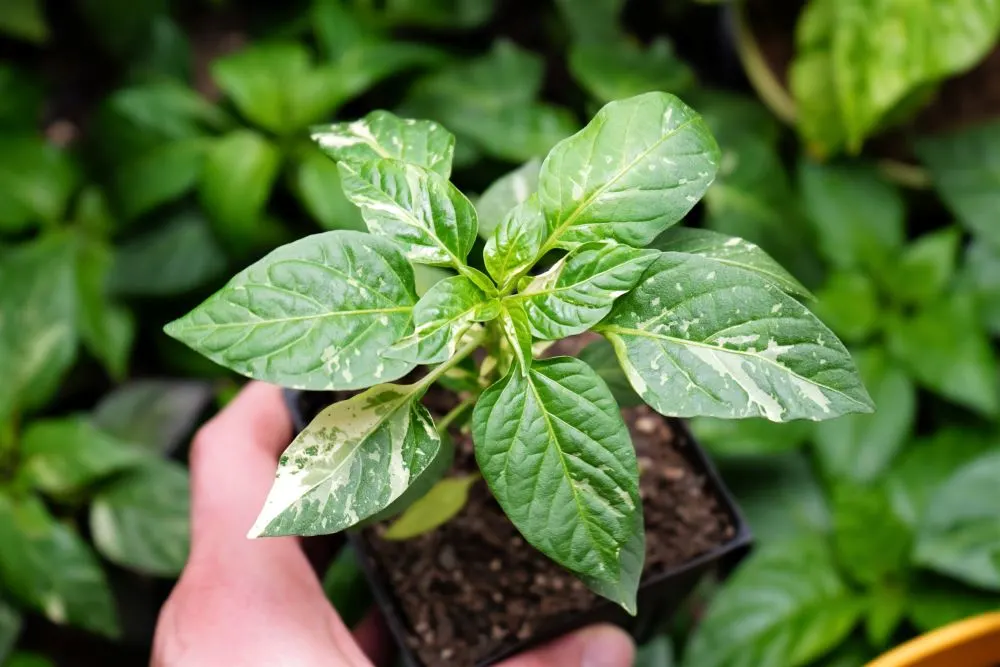
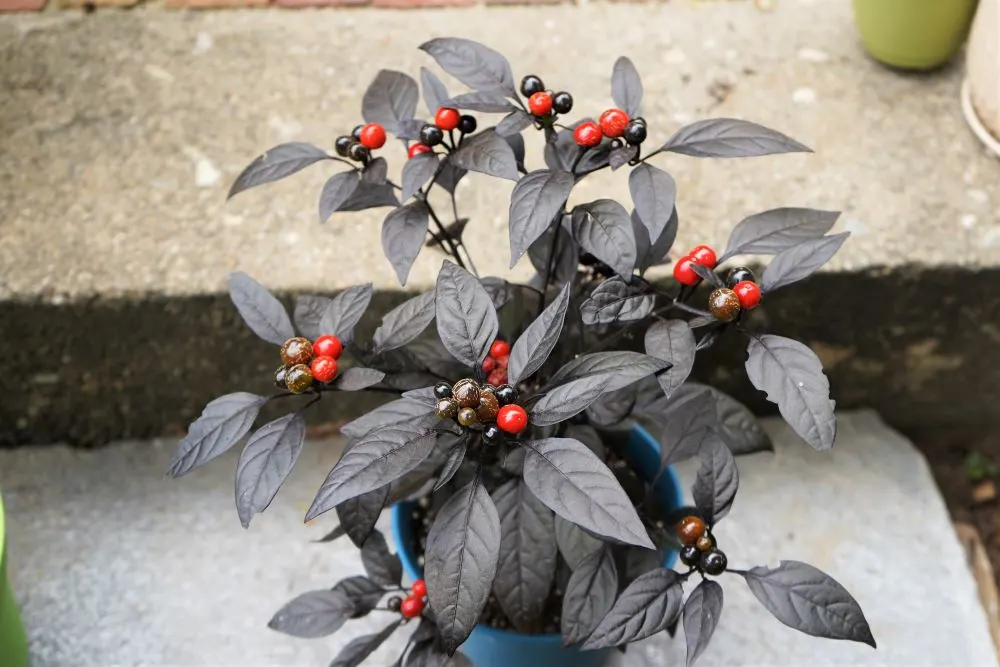
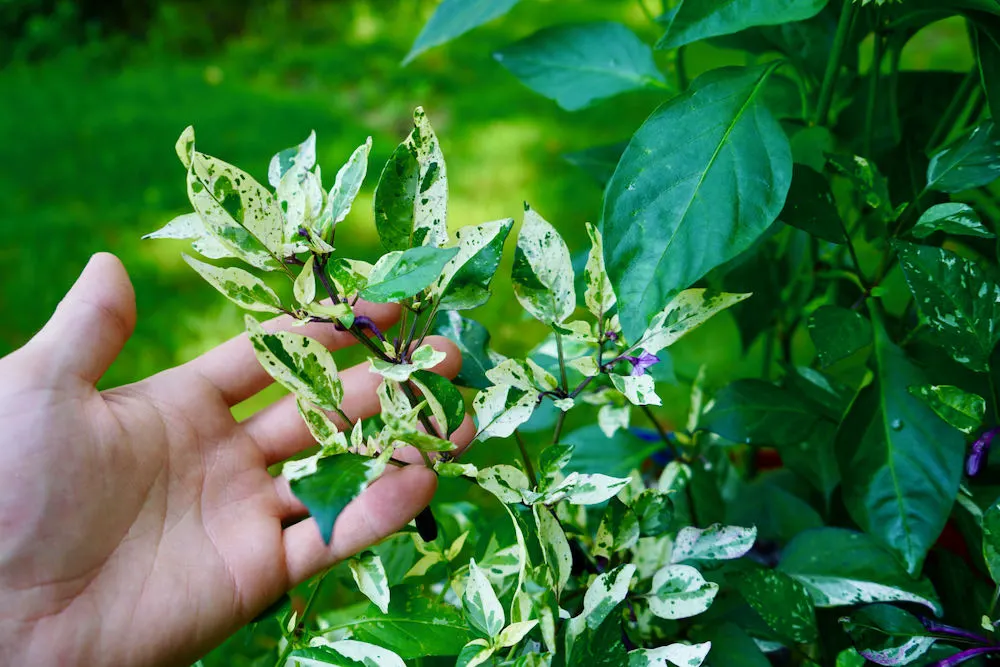
Many of the plants with unique foliage are grown simply for ornamental purposes. However, every variety also produces edible fruit. Some of the ornamentals can have bitter fruits, but many are also delicious and useful in the kitchen.
Productivity
Yield is important for most vegetable gardeners. The amount of peppers each plant produces varies widely based on the variety. Some plants have been bred to produce heavy yields, while others are bred for their appearance or high heat level.
Jalapenos, poblanos, and bell peppers all produce heavy yields. Cayennes produce less by weight, but have higher heat level for making cayenne powder and hot sauces. Yield potential also depends heavily on growing conditions – more light, water, and nutrients will lead to a bigger harvest.
Capsicum Annuum Flavors And Uses
There is a reason that peppers are one of the most popular summer crops around the world. Gardeners from every corner of the planet are growing chiles for their tasty flavors and unique spice.
Flavors
If you have only ever tasted a bell pepper, then you are missing out! While they are sweet and crunchy, there is another world of flavor to be explored in this one Capsicum species.
Thai chiles offer high heat level with a fruity, bright taste. Hatch chiles are vegetal and smoky. Jalapeños are commonly smoked (chipotles), and make a wonderfully spicy and smoky powder. Pasilla (dried chilaca) and ancho (dried poblano) have a distinct raisin-like aroma and flavor.
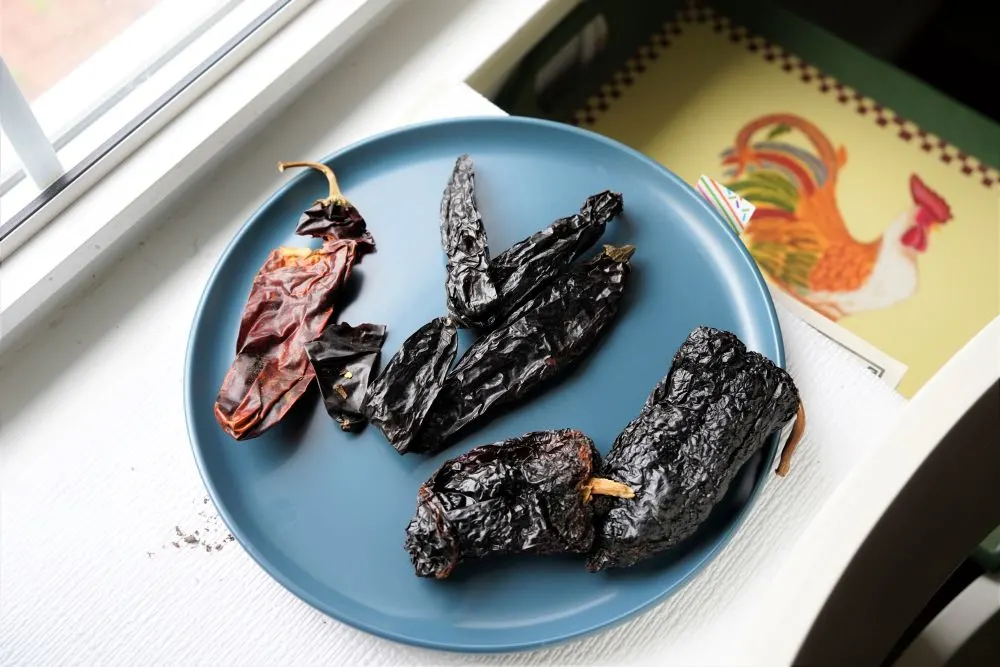
Another important note is that peppers will change flavor dramatically when fully ripe. Some types are eaten when unripe (green jalapenos and bell peppers). However, a red bell pepper has a much different flavor than its underripe green counterpart. Usually, ripe peppers have a higher nutrient content, and a sweeter, milder flavor.
Heat also ranges from none (0 SHUs) all the way to over 100,000 SHUs in some varieties. This is pretty spicy, but it doesn’t even come close to the extremely hot varieties within Capsicum chinense.
Uses
Rounding up all of the possible uses for Capsicum annuum peppers would be a daunting task. These peppers vary so widely in flavor around the globe that each culture has crafted unique dishes and flavors with their local cultivars.
In North America, there are many popular dishes that rely on various C. annuum peppers. Here are some great ways to use your fresh or dehydrated chiles.
- Stuffing. From chiles rellenos to jalapeño poppers, stuffing is a popular use for many annuum type peppers. Oh, and don’t forget about good old fashioned stuffed bell peppers – a delicious and easy dinner!
- Salsas. Salsa just wouldn’t be the same without the bite from jalapeno peppers. Whether it is a sweet pineapple salsa, or a classic fresh tomato and onion salsa, we always include spicy jalapeños or serranos to heat it up.
- Powders. If you grow your own jalapeños or cayennes, making homemade powder is a great way to use up a big harvest. The dehydrated peppers easily grind into a fine powder that will stay good for months, and will be much more flavorful than store bought spices.
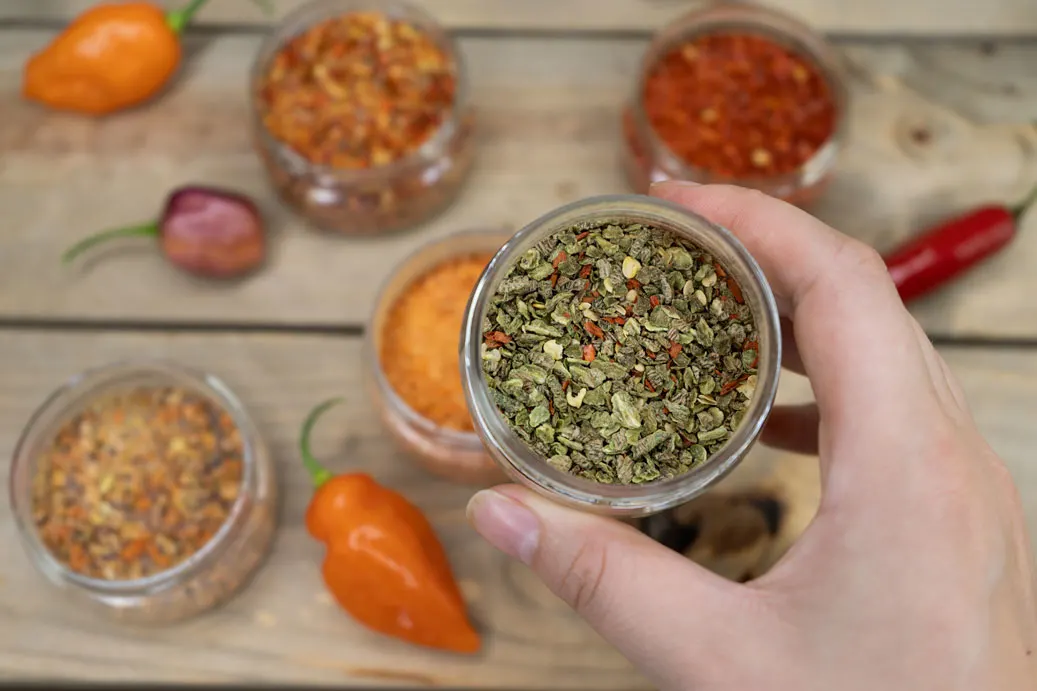
- Sauces. If you haven’t tried it yet, making homemade hot sauce is lots of fun. It is a great way to experiment with your harvests and find new flavors to enjoy on your food.
- Frying. Thai peppers, shishitos, and many other C. annuum peppers are primarily used in cooking. Shishitos make a delicious appetizer when fried in hot oil with a pinch of salt and black pepper.
We love experimenting with our fresh pepper harvests. There are countless options to choose from, including fermentation, cooking fresh, and simply storing for later use.
Growing Capsicum Annuum Plants
If you want to see the true diversity of the Capsicum annuum species, then you’ll have to learn to grow your own peppers. Thankfully, this is easy! We specialize in growing peppers, and have many articles on how to grow peppers from seed.
Want to learn how to grow peppers? Check out our eBook, ‘Growing Perfect Peppers’ for our most detailed guide to growing from seed to harvest.
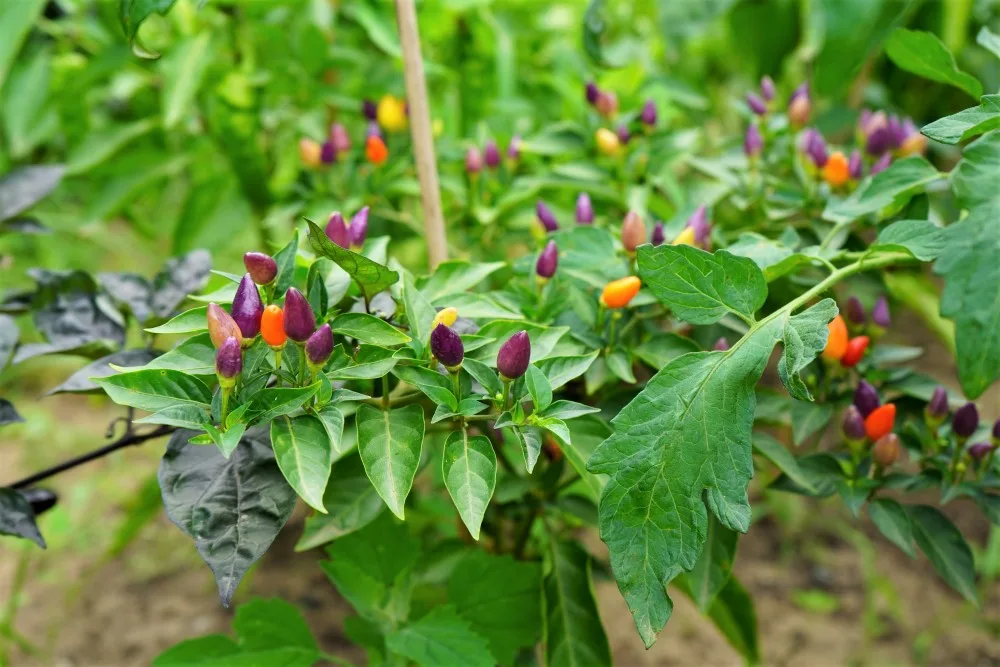
If you’re just starting out, I’d recommend growing in pots. All of the C. annuum varieties lend themselves well to container gardening. They are easy to grow from seed, and can be grown almost anywhere, even without having your own yard. We grow dozens of peppers on our balcony for years!
If you have more space, browse our favorite seed suppliers to discover the many amazing varieties that you can grow yourself.
I hope this article has inspired you to explore the amazing world of Capsicum annuum plants. If you’re growing your own peppers, try something unique and special to share with your friends and family!


Steve Miller
Monday 29th of August 2022
Thanks for the greatest info. I have an unrelated question. This year was my first real attempt at growing peppers and I may have been a bit overzealous/ inexperienced when planting my seeds. In each pot I planted 3 jalapeño, 3 habanero, and 3 ghost pepper seeds. In each pot 5,6, or 7 of the seeds sprouted so they are basically bushes more than plants however I’ve noticed that only one type of pepper has flowered in each pot. How is it possible that I only planted 3 seeds of each type yet I appear to have 5-6 “plants” that are all the same in one pot? However I have noticed my jalapeño’s are extremely hot. Just wondering how/ why this happened. Thanks for your time.
peppergeek
Monday 29th of August 2022
It could be a seed source issue/mistake. Where'd you get your seeds? Pepper plants will not "cross" with each other during a single growing generation, so it is not that.